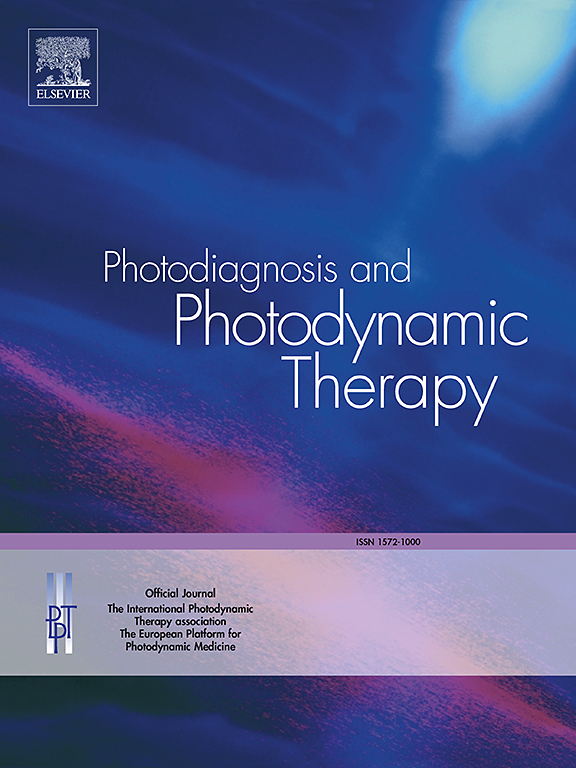非手术机械清创联合或不联合抗微生物光动力治疗化疗患者种植体周围炎的疗效。
IF 3.1
3区 医学
Q2 ONCOLOGY
引用次数: 0
摘要
目的:研究表明,单次抗菌光动力治疗(aPDT)作为机械清创(MD)的辅助治疗种植体周围疾病是有效的。目的是评估MD合并和不合并aPDT治疗化疗患者种植体周围炎的疗效。方法:纳入种植体周围炎患者。这些个体被分为两组(a)接受化疗的种植体周围炎患者;(b)患有种植体周围炎的全身健康患者。这些个体被进一步细分为两个亚组:(a)单独接受NSMD的个体和(b)接受NSMD并辅助aPDT的个体。采用塑料刮管进行非手术MD。采用680 nm二极管激光器,功率和功率密度分别为150 mW和1.1 mW/cm2。将光敏剂放置在植入体周围的口袋中,放置60秒后,使用直径为600 μm的光纤传输激光。在基线和3个月后测量种植体周围改良菌斑和牙龈指数(mPI和mGI)、探探深度(PD)和牙冠骨质流失(CBL)。采用单向方差分析和Bonferroni事后调整检验进行组间比较。p值小于0.05被认为具有统计学意义。结果:在基线时,接受化疗的患者与全身健康的种植周炎患者的种植周mPI、mGI、PD和CBL无统计学差异。在三个月的随访中,化疗患者和全身健康的种植周炎患者的种植周mPI、mGI、PD和CBL与各自的基线评分相比无统计学差异。结论:在接受化疗的患者和全身健康的个体中,单次aPDT和NSMD治疗种植体周围炎无效。然而,参与者的口腔卫生不佳和短期随访可能影响了结果。因此,需要进一步的长期随访临床试验,包括MD后多次aPDT治疗。本文章由计算机程序翻译,如有差异,请以英文原文为准。
Efficacy of non-surgical mechanical debridement with and without adjunct antimicrobial photodynamic therapy in the treatment of peri-implantitis among patients undergoing chemotherapy
Objective
Studies have shown that a single session of antimicrobial photodynamic therapy (aPDT) as an adjunct to mechanical debridement (MD) is effective for treating peri‑implant diseases. The objective was to assess the efficacy of MD with and without adjunct aPDT in treating peri‑implantitis among patients undergoing chemotherapy.
Methods
Patients with peri‑implantitis were included. These individuals were divided into two groups (a) patients with peri‑implantitis undergoing chemotherapy; (b) systemically healthy patients with peri‑implantitis. These individuals were further subclassified into two subgroups: (a) individuals that received NSMD alone and (b) individuals that underwent NSMD with adjunct aPDT. Non-surgical MD was performed using plastic curettes. The aPDT was performed using a 680 nm diode laser at a power and power density of 150 mW and 1.1 mW/cm2, respectively. The photosensitizer was placed in the peri‑implant pocket and left in place for 60 s following which the laser was applied using a using an optical fiber with a diameter of 600 μm. Peri-implant modified plaque and gingival indices (mPI and mGI), probing depth (PD) and crestal bone loss (CBL) were measured at baseline and after three months. Group comparisons were performed using one way analysis of variance and Bonferroni post-hoc adjustment tests. P-values <0.05 were considered statistically significant.
Results
At baseline, there was no statistically significant difference in peri‑implant mPI, mGI, PD and CBL among patients undergoing chemotherapy and systemically healthy individuals with peri‑implantitis. At three months’ follow up, there was no statistically significant difference in peri‑implant mPI, mGI, PD and CBL among patients undergoing chemotherapy and systemically healthy individuals with peri‑implantitis compared to their respective baseline scores.
Conclusion
Among patients undergoing chemotherapy and systemically healthy individuals, a single session of aPDT and NSMD is ineffective in the treatment of peri‑implantitis. Nevertheless, poor oral hygiene of the participants and the short-term follow-up may have influenced the results. Hence further long-term follow-up clinical trials involving multiple sessions of aPDT after MD are needed.
求助全文
通过发布文献求助,成功后即可免费获取论文全文。
去求助
来源期刊

Photodiagnosis and Photodynamic Therapy
ONCOLOGY-
CiteScore
5.80
自引率
24.20%
发文量
509
审稿时长
50 days
期刊介绍:
Photodiagnosis and Photodynamic Therapy is an international journal for the dissemination of scientific knowledge and clinical developments of Photodiagnosis and Photodynamic Therapy in all medical specialties. The journal publishes original articles, review articles, case presentations, "how-to-do-it" articles, Letters to the Editor, short communications and relevant images with short descriptions. All submitted material is subject to a strict peer-review process.
 求助内容:
求助内容: 应助结果提醒方式:
应助结果提醒方式:


